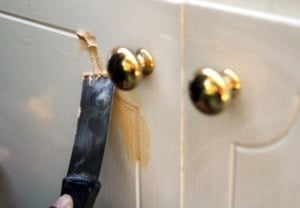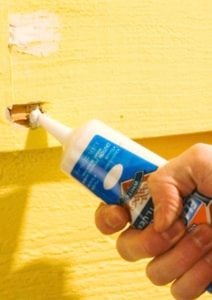How To Use Wood Filler
When it comes to fixing stuff, I like to try to do it myself before calling anyone. That said, there are some things that are more difficult to do from start to finish, and require a truly skilled craftsman. For me, that is woodworking. I possess neither the tools nor the skills to replicate the woodwork that is in my turn of the century house. I did want to keep the original character of the home, but some of the wood in the trim, moldings, even the floor had gouges, nicks and scratches that were too big to ignore, and having them replicated and replaced was more than we could afford. So I decided to try one of the under appreciated tools in the tool box- wood filler.
We use wood filler all the time in the cabinet business, and for the homeowner willing to give it a try, it will soon become an old favorite. When it comes to fixing stuff in old homes, no one says it quite like Bob Villa-
How To: Use Wood Filler
Use wood filler to repair scratches, chips, gouges and other surface imperfections in the furniture and trim work around your home, effectively and efficiently.

Photo: suemartinteam.com
Scarred flooring, rotted window frames, chipped furniture—common problems like these can be time-consuming and expensive to repair. Or they can be dealt with quickly and affordably by homeowners who know how to use wood filler. If you’ve never worked with this stuff before, get excited: It might soon be your favorite item in the toolbox. Simple in concept and easy to apply, wood filler works wonders to remedy surface imperfections in a vast, varied range of household items.

Photo:diyadvice.com
Which type of wood filler should you use? The answer depends largely on the job. As the name suggests, stainable wood fillers are receptive to staining so that once you’ve applied the product, you can stain over it to ensure the repaired section matches the rest of the piece that you’re fixing. Typically, water-based wood fillers may also be stained (or painted), but unlike other products in the same category, these are specially formulated for use indoors. Common applications are molding, paneling, and cabinetry. Heavy-duty solvent-based wood fillers are meant primarily for outdoor use and perform well on exterior siding and trim.
MATERIALS AND TOOLS
– Sandpaper
– Shop vac (or tack cloth)
– Wood filler
– Putty knife
– Polyurethane sealer
– Paint or stain
Working with wood filler may at first blush strike you as messy and haphazard, but precise results are not only possible, they are in fact rather easy to achieve. It’s important to note, however, that wood filler is intended strictly for superficial issues, such as scratches and gouges. If the damage calls for a proper repair, wood filler is no substitute. That said, there’s no shortage of ways in which to use wood filler to improve the look of both practical and decorative elements that have seen better days.
STEP 1
Start by preparing the surface to which you are going to apply wood filler. For one, that means removing any loose chunks of wood or flaking paint. Next, sand any rough edges in or immediately adjacent to the damaged area you wish to repair. Finally, clear away all lingering dust and debris by means of a shop vac or moistened tack cloth (if you use the latter, wait for the area to dry completely before you proceed).
STEP 2
Now, apply the wood filler using a putty knife. Start at the edge of the damaged area, pressing the wood filler into the depression. Overfill slightly to allow for the fact that the filler shrinks as it dries. Once you have applied as much filler as necessary, smooth over the filled area with a clean part of the putty knife.
STEP 3
Allow as much time as needed for the wood filler to dry. Depending on the depth of the application, that could take anywhere from 15 minutes to eight hours. Once dry, sand the filled area so that its height is flush with the surrounding wood. When you run your hand over both the undamaged and freshly filled parts of the item you are fixing, you should feel only the slightest difference between the two.
STEP 4
Having sanded the area smooth, complete the project by applying your choice of finish. In most cases, the goal will be to make the repair virtually unnoticeable. So if you’ve been working on a baseboard painted white, concealing the fix is simply a matter of painting over the filled area in the same shade.
Stained pieces are trickier to deal with. For the best possible match, it’s recommended that you dab some wood filler onto a piece of scrap wood. Wait for it to dry, then test the stain to see how it looks. Depending on the test results, you may then choose to thin out the stain, use a different color, or (if you got a close enough match) proceed to apply the stain to the item that you’ve now successfully fixed—cheaply, easily, and possibly in less than an hour.

.png)